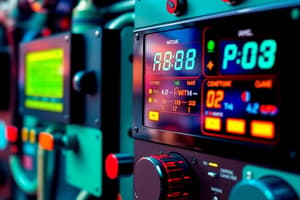Podcast
Questions and Answers
شنو التأثير لي عندو حجم وشكلة المادة على اختيار آلة الطحن؟
شنو التأثير لي عندو حجم وشكلة المادة على اختيار آلة الطحن؟
- ما يأثروش على الاختيار
- يقللوا من دقة العملية
- يأثروا على سرعة القطع فقط
- يحددوا نوع الأداة المستعملة (correct)
كيفاش يؤثر عمق القطع على فعالية وجودة عملية الطحن؟
كيفاش يؤثر عمق القطع على فعالية وجودة عملية الطحن؟
- كلما زاد، كلما نقصت الفعالية
- ما يؤثرش على الجودة
- يأثر على جودة السطح فقط
- يساهم في رفع فعالية الإزالة (correct)
علاش الدعم الجيد للمادة مهم في عملية الطحن؟
علاش الدعم الجيد للمادة مهم في عملية الطحن؟
- لأنه يسرع من العملية
- لأنه يزيد من سرعة الأداة
- لأنه يقلل من استهلاك السوائل
- لأنه يمنع اهتزازات و تشوهات (correct)
شنو الفرق الرئيسي بين عملية الدوران وعملية الطحن؟
شنو الفرق الرئيسي بين عملية الدوران وعملية الطحن؟
كيفاش تؤثر السوائل المستخدمة في عملية الطحن؟
كيفاش تؤثر السوائل المستخدمة في عملية الطحن؟
ماذا يهدف عملية الدوران في التصنيع؟
ماذا يهدف عملية الدوران في التصنيع؟
ما هي إحدى الطرق المستخدمة في عملية الدوران؟
ما هي إحدى الطرق المستخدمة في عملية الدوران؟
ما هي العوامل الأساسية في اختيار عملية الدوران المناسبة؟
ما هي العوامل الأساسية في اختيار عملية الدوران المناسبة؟
ما هو الغرض من استخدام سوائل القطع أثناء الدوران؟
ما هو الغرض من استخدام سوائل القطع أثناء الدوران؟
كيف تختلف عملية الطحن عن عملية الدوران؟
كيف تختلف عملية الطحن عن عملية الدوران؟
ما الذي يؤثر على جودة كفاءة عملية الطحن؟
ما الذي يؤثر على جودة كفاءة عملية الطحن؟
ما هي إحدى الطرق المستخدمة في عملية الطحن؟
ما هي إحدى الطرق المستخدمة في عملية الطحن؟
ما هو نوع الأداة الذي يستخدم في عملية الطحن؟
ما هو نوع الأداة الذي يستخدم في عملية الطحن؟
Flashcards
اعتبارات قطعة العمل
اعتبارات قطعة العمل
تؤثر مواد العمل و حجمها و شکلها على اختيار آلة الطحن والمبرد.
معلمات التصنيع
معلمات التصنيع
تحدد سرعة التغذية وسرعة القطع وعمق القطع كفاءة عملية الطحن وجودته.
دعم قطعة العمل
دعم قطعة العمل
يجب أن يكون الدعم مناسب، في مراحل الطحن لتجنب انحراف وتشوه قطعة العمل.
سوائل القطع
سوائل القطع
Signup and view all the flashcards
الاختلافات بين التشغيل و الطحن
الاختلافات بين التشغيل و الطحن
Signup and view all the flashcards
التدوير
التدوير
Signup and view all the flashcards
التقطيع
التقطيع
Signup and view all the flashcards
أداة القطع أحادية النقطة
أداة القطع أحادية النقطة
Signup and view all the flashcards
أداة القطع متعددة النقاط
أداة القطع متعددة النقاط
Signup and view all the flashcards
سرعة التغذية
سرعة التغذية
Signup and view all the flashcards
سرعة القطع
سرعة القطع
Signup and view all the flashcards
عمق التقطيع
عمق التقطيع
Signup and view all the flashcards
سائل التبريد
سائل التبريد
Signup and view all the flashcards
Study Notes
Introduction to Turning and Milling
- Turning and milling are fundamental machining processes for shaping parts from various materials.
- Both use cutting tools to remove material from workpiece blanks.
- Turning creates cylindrical shapes, while milling produces flat surfaces and intricate profiles.
Turning
- Definition: Turning uses a single-point cutting tool to remove material from a rotating workpiece.
- Purpose: Creates cylindrical surfaces (shafts, rods, parts with rotational symmetry).
- Methods:
- Facing: producing a flat surface on the end of a workpiece.
- External turning: creating external cylindrical surfaces.
- Internal turning: creating internal cylindrical surfaces.
- Threading: creating threads on a workpiece.
- Tool Geometry: Tool shape and angles (rake angle, clearance angle, nose radius) affect chip formation, surface finish, and tool lifespan.
- Material Removal: Material is progressively removed by the rotating cutting tool.
- Workpiece Considerations: Workpiece material, diameter, and length impact process choice.
- Machining Parameters: Feed rate, cutting speed, and depth of cut influence process quality and efficiency.
- Cutting Fluids: Lubricate and cool the cutting zone, enhancing surface finish and tool life.
Milling
- Definition: Milling uses a multi-point cutting tool (milling cutter) to remove material from a stationary or rotating workpiece.
- Purpose: Creates flat surfaces, slots, grooves, and complex 3D shapes.
- Methods:
- Face milling: producing flat surfaces.
- End milling: creating grooves and slots.
- Peripheral milling: machining large surfaces.
- Profile milling: machining complex shapes.
- Tool Geometry: Milling cutters have multiple cutting edges and specific geometries (e.g., end mill, face mill).
- Material Removal: Multiple cutting edges of the cutter remove material.
- Workpiece Considerations: Workpiece material, size, and shape impact cutter and machine selection.
- Machining Parameters: Feed rate, cutting speed, and depth of cut influence process efficiency and quality.
- Workpiece Support: Crucial for preventing workpiece deflection and distortion during milling.
- Cutting Fluids: Utilised for lubrication and cooling during milling, improving surface finish and tool life.
Commonalties
- Both turning and milling require careful consideration of cutting parameters (speed, feed, depth of cut) for optimal material removal and tool life.
- Proper selection of cutting tools (geometry, material) is crucial for efficient machining.
- Appropriate workpiece support is vital to minimise vibrations and ensure dimensional accuracy.
- Safety precautions are essential to prevent workplace injuries.
Differences
- Turning uses a single-point cutting tool; milling uses a multi-point tool.
- Turning creates predominantly cylindrical surfaces; milling creates a wider variety of 2D and 3D shapes.
- Turning typically involves a rotating workpiece; milling can involve a rotating cutter or a moving workpiece.
Studying That Suits You
Use AI to generate personalized quizzes and flashcards to suit your learning preferences.




